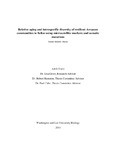Relative Aging and Intraspecific Diversity of Resilient Acropora Communities in Belize Using Microsatellite Markers and Somatic Mutations (thesis)

Author
Irwin, Adele E.
Subject
Washington and Lee University -- Honors in Biology
Coral reef ecology
Coral reef conservation -- Research
Coral reef biology -- Research
Belize -- Ambergris Cay
Acropora
Metadata
Show full item recordDescription
Thesis; [FULL-TEXT RESTRICTED TO WASHINGTON AND LEE UNIVERSITY LOGIN] Adele E. Irwin is a member of the Class of 2015 of Washington and Lee University. Historically and geologically, Acropora palmata and Acropora cervicornis have been key reef framework builders, yet in the Caribbean these species have faced significant mortality over the last few decades. Today, Acropora populations persist in large numbers with high live coral cover at few Caribbean sites. While many studies have focused on the recent demise of these species, data from areas where Acropora spp. have continued to thrive is less available. Understanding the genetic diversity, reproductive history, and temporal persistence of healthy populations of Acropora spp. may provide insight into the potential for these populations to continue to thrive. We studied three reef sites with highly abundant Acropora cervicornis, Acropora palmata, and Acropora prolifera populations offshore of Ambergris Caye, Belize; Coral Gardens, Manatee Channel, and Rocky Point. Genetic data was collected from all three Acropora species to determine the clonal composition and relative ages of Acropora colonies. We used five microsatellite markers to determine 1) genotypic diversity, 2) dominant reproductive style, and 3) minimum and maximum genet age estimates of all three acroporids at these sites. Acropora populations were highly clonal and likely reproduced primarily asexually via fragmentation across all sites. We estimated the ages of 19 Acropora genets. Minimum age estimates from a new genetic aging technique (based on somatic mutation rates) show minimum ages of between 0 and 409 years old for A. cervicornis, between 0 and 561 years for A. palmata, and between 0 and 281 years old for A. prolifera. These results suggest that Acropora abundance and live coral cover are not driven by high genotypic diversity at these sites, as some have suggested for other Acropora-dominated locations. We also show that at least ten of the genets found at these sites are veterans that survived the recent Caribbean-wide Acropora spp. collapse, suggesting that this site is a refugia for Acropora corals. Adele Irwin